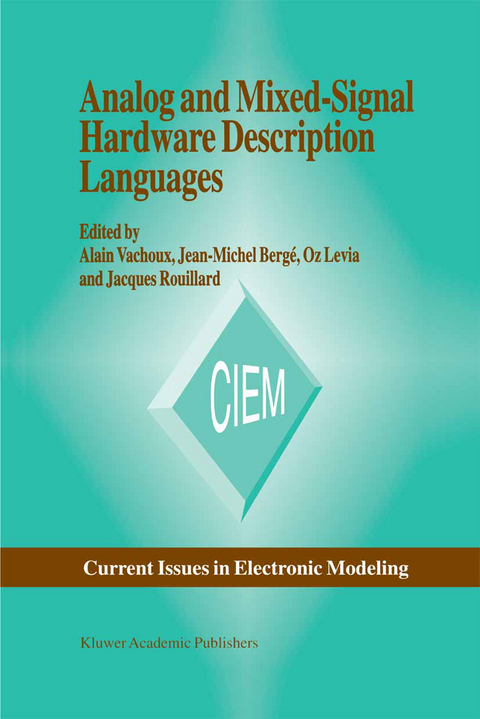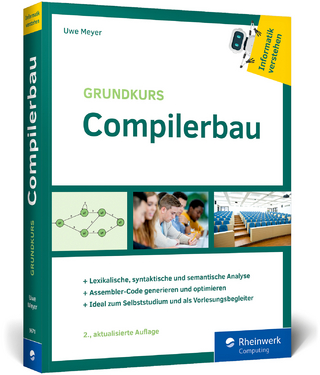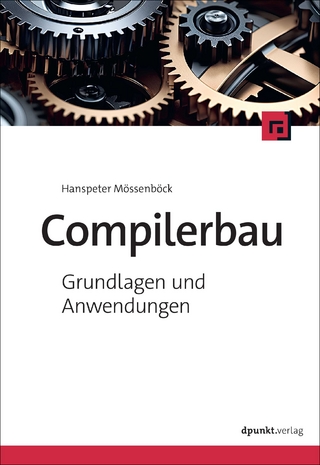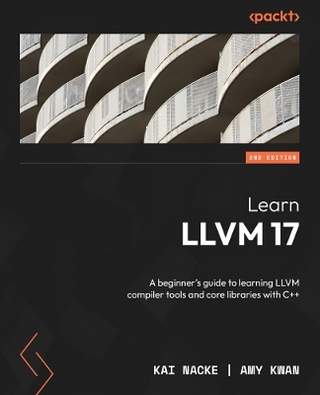
Analog and Mixed-Signal Hardware Description Language
Springer (Verlag)
978-0-7923-9875-2 (ISBN)
Hardware description languages (HDL) such as VHDL and Verilog have found their way into almost every aspect of the design of digital hardware systems. Since their inception they gradually proved to be an essential part of modern design methodologies and design automation tools, ever exceeding their original goals of being description and simulation languages. Their use for automatic synthesis, formal proof, and testing are good examples.
So far, HDLs have been mainly dealing with digital systems. However, integrated systems designed today require more and more analog parts such as A/D and D/A converters, phase locked loops, current mirrors, etc.
The verification of the complete system therefore asks for the use of a single language. Using VHDL or Verilog to handle analog descriptions is possible, as it is shown in this book, but the real power is coming from true mixed-signal HDLs that integrate discrete and continuous semantics into a unified framework. Analog HDLs (AHDL) are considered here a subset of mixed-signal HDLs as they intend to provide the same level of features as HDLs do but with a scope limited to analog systems, possibly with limited support of discrete semantics.
Analog and Mixed-Signal Hardware Description Languages covers several aspects related to analog and mixed-signal hardware description languages including:
The use of a digital HDL for the description and the simulation of analog systems The emergence of extensions of existing standard HDLs that provide true analog and mixed-signal HDLs.
The use of analog and mixed-signal HDLs for the development of behavioral models of analog (electronic) building blocks (operational amplifier, PLL) and for the design of microsystems that do not only involve electronic parts.
The use of a front-end tool that eases the description task with the help of a graphical paradigm, yet generating AHDL descriptions automatically.
Analog and Mixed-Signal Hardware Description Languages is the first book to show how to use these new hardware description languages in the design of electronic components and systems. It is necessary reading for researchers and designers working in electronic design.
1. Applicability of Discrete Event Hardware Description Languages to the Design and Documentation of Electronic Analog Systems.- 1.1. Introduction.- 1.2. Modeling Basic Analog Concepts.- 1.3. Network-Independent Data-Sampled Analog Systems.- 1.4. Network-Dependent Data-Sampled Analog Systems.- 1.5. Summary.- 2. VHDL 1076.1: Analog and Mixed-Signal Extensions to VHDL.- 2.1. Introduction.- 2.2. Foundations.- 2.3. The 1076.1 Language.- 2.4. Examples.- 2.5. Concluding Remarks.- 3. Analog Extensions to Verilog.- 3.1. Introduction.- 3.2. Natures and Disciplines.- 3.3. Network Models.- 3.3. Verilog-A Features.- 3.4. Multi-Disciplinary Modeling.- 3.5. Summary.- 4. Op3:A Behavioral Generic Model of Operational Amplifiers.- 4.1. Introduction.- 4.2. Description of the Generic Op Amp Model op3.- 4.3. Application Examples of the op3 Model.- 4.4. Conclusions.- 5. Non-Linear State Space Averaged Modeling of A 3-State Digital Phase-Frequency Detector.- 5.1. Introduction.- 5.2. Digital 3-State Phase-Frequency Detector Model.- 5.3. Resettable Integrator.- 5.4. Calibration.- 5.5. DC Convergence and AC Analysis.- 5.6. Sample Application.- 5.7. Switched Voltage Output Stage.- 5.8. Conclusions.- Appendix A: SpectreHDL Model.- Appendix B: Verilog Model.- 6. Behavioural Modelling of Analogue Systems with Absynth.- 6.1. Introduction.- 6.2. Analogue Modelling.- 6.3. Graphical Description.- 6.4. Automatic Code Generation.- 6.5. Results.- 6.6. Conclusions.- 7. VHDL-1076.1 Modeling Examples for Microsystem Simulation.- 7.1. Introduction.- 7.2. Modeling Principles.- 7.3. Conservative Systems.- 7.4. Piecewise Linear Models.- 7.5. Signal Flow Models.- 7.6. Piecewise Defined Behavior.- 7.7. Physical Parameter Extraction from Finite Element Simulations.- 7.8. Simulation Results using HDL-A Models.- 7.9.Conclusions.
| Reihe/Serie | Current Issues in Electronic Modeling ; 10 | Current Issues in Electronic Modeling Set Issues 9-12 | 1.20 |
|---|---|
| Zusatzinfo | XX, 158 p. |
| Verlagsort | Dordrecht |
| Sprache | englisch |
| Maße | 155 x 235 mm |
| Themenwelt | Mathematik / Informatik ► Informatik ► Programmiersprachen / -werkzeuge |
| Informatik ► Theorie / Studium ► Compilerbau | |
| Informatik ► Weitere Themen ► Hardware | |
| Technik ► Elektrotechnik / Energietechnik | |
| ISBN-10 | 0-7923-9875-0 / 0792398750 |
| ISBN-13 | 978-0-7923-9875-2 / 9780792398752 |
| Zustand | Neuware |
| Haben Sie eine Frage zum Produkt? |
aus dem Bereich


